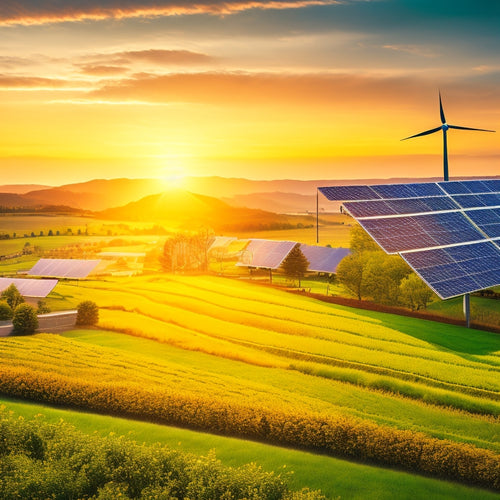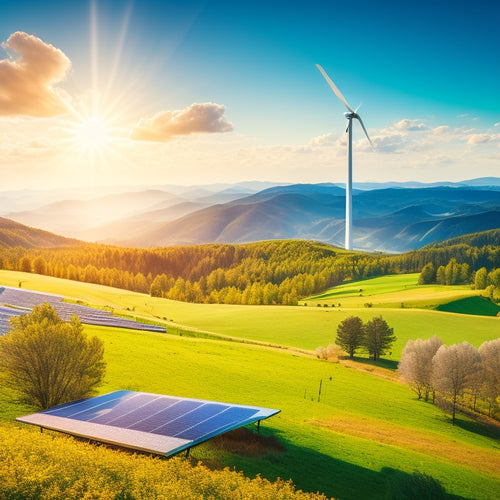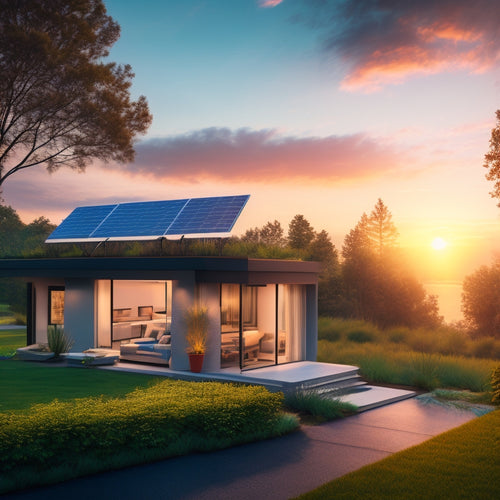
How Much Do Home Renewable Energy Systems Cost
Share
Home renewable energy systems generally cost between $15,000 and $30,000 upfront. However, this investment can translate into significant long-term savings on your energy bills. By taking advantage of federal and state incentives, such as tax credits and rebates, you can effectively lower your initial expenses. Additionally, these systems contribute to reducing your reliance on the grid, offering freedom from fluctuating utility rates. Considering the potential increase in your home's value and the environmental benefits, it's a smart move. If you're curious about how to maximize your investment, there are more observations to investigate.
At a Glance
- Initial investment for solar panel installation ranges from $15,000 to $30,000, depending on system size and location.
- Annual maintenance costs for renewable systems typically range from $100 to $300.
- Tax credits and state incentives can significantly reduce upfront costs for renewable energy installations.
- Battery storage installation costs vary based on capacity and compatibility, impacting long-term savings.
- Overall costs can be offset by lower energy bills and financial incentives, enhancing affordability.
Lower Long-Term Energy Costs
Investing in home renewable energy systems can greatly reduce your long-term energy costs.
By utilizing incentives and tax benefits, you can offset your initial investment while enjoying substantial savings on your monthly energy bills.
This smart financial move not only lightens your wallet but also supports a sustainable future.
Energy Bill Savings
Switching to home renewable energy systems can greatly reduce your energy bills over time. By utilizing solar, wind, or other renewable sources, you can considerably decrease your reliance on the grid, leading to substantial energy savings. This change not only enhances your energy efficiency but also allows for better cost forecasting, helping you manage your finances more effectively.
Consider the long-term benefits: while the upfront investment in renewable energy systems may seem intimidating, the savings on your monthly energy bills can quickly offset those costs. As energy prices continue to rise, having your own energy source protects you from unpredictable future expenses. You'll gain freedom from fluctuating utility rates and enjoy more control over your budget.
Moreover, renewable systems often require lower maintenance and operational costs than traditional energy sources. By investing in these technologies, you're not just saving money; you're also making a statement about your commitment to sustainable living.
Ultimately, the shift to renewable energy can enable you to take control of your energy future, ensuring that you enjoy both financial savings and the freedom that comes with self-sufficiency.
Incentives and Tax Benefits
Numerous incentives and tax benefits are available to homeowners who choose renewable energy systems, making the shift not only environmentally friendly but financially savvy. By leveraging these incentives, you can greatly reduce the upfront costs of installation while enjoying long-term savings.
| Incentive Type | Description | Benefits |
|---|---|---|
| Federal Incentives | Tax credits and deductions available at the federal level. | Reduce your tax burden greatly. |
| State Rebates | Financial support from state governments for renewable installations. | Lower initial costs and quicker ROI. |
| Utility Programs | Discounts or rebates offered by local utility companies. | Offset installation costs, enhance energy efficiency. |
Utilizing federal incentives and state rebates, you can effectively decrease your investment. Additionally, financing options and installation grants can make renewable energy accessible. If you conduct home evaluations, you might qualify for renewable credits, further enhancing your savings. Remember to investigate local initiatives, as they often provide helpful resources and support. By taking advantage of these financial tools, you not only equip yourself with energy independence but also contribute to a sustainable future.
Environmental Impact Reduction
Switching to renewable energy systems in your home considerably lowers your carbon footprint, making a direct impact on climate change.
By utilizing sustainable energy sources, such as solar panels, you not only reduce reliance on fossil fuels but also contribute to a healthier environment.
These systems can also enhance your property value as they represent a commitment to sustainability, potentially increasing resale value by up to 17% increased property value.
Adopting these systems isn't just an investment in your future; it's a commitment to a more sustainable planet.
Lowering Carbon Footprint
Reducing your carbon footprint isn't just an individual choice; it's a crucial step toward mitigating climate change and preserving the environment for future generations.
By adopting home renewable energy systems, you take a proactive stance in lowering greenhouse gas emissions. This shift not only contributes to a healthier planet but also aligns with your desire for freedom from dependency on fossil fuels.
Implementing carbon offset strategies is fundamental in this process. You can invest in projects that reduce emissions elsewhere, balancing out your own footprint. For instance, planting trees or supporting renewable energy initiatives can effectively offset the carbon you produce.
Incorporating sustainable practices at home also plays an essential role. Simple changes, like energy-efficient appliances and solar panels, can greatly diminish your environmental impact.
These choices enable you, giving you control over your energy consumption while promoting a cleaner, greener lifestyle.
Ultimately, by reducing your carbon footprint, you're not just benefiting yourself; you're contributing to a collective effort for a sustainable future.
Each decision you make has the potential to inspire others, nurturing a community dedicated to environmental stewardship and freedom from harmful energy practices.
Sustainable Energy Sources
As you adopt the goal of lowering your carbon footprint, consider the significant role sustainable energy sources play in environmental impact reduction.
Wind energy, for instance, exploits the natural currents of the atmosphere, providing a clean alternative to fossil fuels. By investing in geothermal systems, you tap into the Earth's internal heat, offering efficient and consistent energy.
Hydroelectric power generates electricity through flowing water, showcasing how nature can fuel our needs sustainably.
Incorporating biomass energy allows you to employ organic materials as fuel, creating a closed-loop cycle that minimizes waste.
Moreover, energy storage solutions enable you to capture excess energy for later use, ensuring that your energy consumption aligns with availability.
System Components Overview
When evaluating a home renewable energy system, you'll need to pay close attention to solar panel expenses and battery storage costs. These components greatly impact your overall investment and can influence your long-term savings.
Additionally, various factors, such as installation labor and project management fees, can affect the total costs associated with your renewable energy system, making it essential to evaluate financial incentives that may be available to help offset your expenses.
Understanding their costs helps you make informed decisions that enhance both your energy independence and financial efficiency.
Solar Panel Expenses
Steering through the expenses associated with solar panel systems reveals a complex terrain of components that can considerably impact your overall investment.
When you decide to install solar panels, you'll face several key costs, primarily installation costs and maintenance expenses.
Installation costs can vary widely based on factors like the size of your system, your location, and the complexity of the installation process. For a typical residential setup, you might expect to spend anywhere from $15,000 to $30,000 upfront.
However, you can often offset these costs through tax credits and incentives, which makes the initial investment more manageable.
Once your system is up and running, don't overlook maintenance expenses. While solar panels are generally low-maintenance, periodic cleaning and inspections are essential to guarantee peak performance.
Depending on your system and how hands-on you want to be, you might spend an additional $100 to $300 annually on maintenance.
Ultimately, understanding these expenses helps you make informed decisions about your solar investment.
Battery Storage Costs
Battery storage systems play an essential role in maximizing the efficiency of your renewable energy setup, yet their costs can greatly influence your overall investment. When considering installation pricing, you'll find that these systems can range markedly based on capacity scaling and system compatibility with your existing infrastructure. A higher capacity could mean a larger upfront cost, but it often leads to greater energy independence and savings in the long run.
Evaluate battery lifespan as a vital factor; newer technology advancements have improved lifespans, often exceeding 10 years. This means lower maintenance expenses and less frequent replacements.
Performance metrics are essential, too, as they'll help you gauge how well your system meets your energy needs.
Don't overlook financing options available for battery storage. Many programs can ease the initial financial burden, allowing you to invest in a system that suits your lifestyle and energy goals.
Selecting Based on Energy Usage
To choose the right renewable energy system for your home, you need to assess your energy needs carefully.
Conducting a load analysis will help you calculate your daily energy consumption in watt-hours, ensuring you select a system that meets those demands effectively.
Understanding your usage patterns will help you determine how much energy you consume on average, allowing you to select a system that meets those demands effectively.
Assessing Energy Needs
Understanding your energy needs is essential for selecting the right renewable energy system for your home. To start, you need to conduct an efficiency assessment of your current energy consumption. This means examining your electricity bills, identifying peak usage times, and determining which appliances consume the most energy.
By doing this, you can pinpoint areas where you can cut back and potentially save money, allowing you to invest more wisely in renewable solutions.
Next, consider your long-term energy goals. Do you want to be completely off-grid, or are you looking to supplement your existing power supply? Knowing this will help you decide the size and type of renewable system that suits your needs.
For instance, if you have high energy consumption due to heating or cooling, a larger solar array might be necessary.
Ultimately, taking the time to assess your energy needs enables you to make informed decisions. This approach not only promotes efficiency but also aligns with your desire for freedom from fluctuating energy prices.
Understanding Usage Patterns
Energy usage patterns play a crucial role in determining the most effective renewable energy system for your home. By conducting a thorough usage analysis, you can uncover your consumption trends and make informed decisions that align with your lifestyle.
Start by monitoring your electricity bills over the past year. This data reveals peak usage times and helps you identify high-consumption appliances.
Understanding when and how you use energy allows you to choose a renewable system that meets your needs. For instance, if you use more energy during the day, solar panels could be a perfect fit. Alternatively, if your consumption peaks in the evening, you might benefit from a hybrid system that combines solar with battery storage.
With this knowledge, you're not just investing in a system; you're equipping yourself to reduce reliance on traditional power sources. This freedom to control your energy future can lead to substantial savings and a more sustainable lifestyle.
Higher Energy Independence Potential
When you invest in home renewable energy systems, you greatly reduce your dependence on utility companies.
This shift not only enables you to control your energy costs but also enhances your resilience against fluctuating energy prices.
Reduced Utility Dependence
Achieving reduced utility dependence through renewable energy systems not only enhances your energy independence potential but also enables you to take control of your energy future. By investing in solar panels, wind turbines, or other renewable technologies, you're not just generating power; you're reinforcing your home against rising utility costs and unpredictable energy markets.
The grid resilience benefits of renewable energy systems are significant. When you're less reliant on traditional utility companies, you can weather outages and spikes in demand with greater ease. This independence translates into energy security advantages, ensuring that your home remains powered during emergencies or grid failures. You gain peace of mind knowing that you're less vulnerable to external disruptions.
Moreover, by utilizing renewable energy, you can actively contribute to a sustainable future. This alignment with eco-friendly practices not only reduces your carbon footprint but also positions you as a proactive participant in the energy arena.
Ultimately, embracing renewable energy systems enables you to break free from conventional energy constraints, nurturing a lifestyle that champions both freedom and responsibility. Take this step toward energy independence, and experience the significant effects of reduced utility dependence.
Frequently Asked Questions
What Are the Average Installation Costs for Home Renewable Energy Systems?
When considering installation costs for home renewable energy systems, solar panel prices typically range from $15,000 to $25,000, while wind turbine costs can vary from $30,000 to $70,000. Investing now can enhance your energy independence.
Are There Financing Options Available for These Systems?
When you commence your renewable energy adventure, investigate financing options like loans and leases. Many government incentives await, helping you seize freedom from traditional energy. Welcome these choices; they're your key to sustainable living.
How Long Is the Typical Payback Period for Renewable Energy Investments?
The typical payback period for renewable energy investments ranges from five to ten years. With incentive programs enhancing your savings, you'll enjoy significant energy savings and greater freedom from rising utility costs sooner than you think.
Can I Install Renewable Energy Systems Myself?
You can install renewable energy systems yourself if you're knowledgeable about DIY installation and guarantee system compatibility. This approach enables you to save money while taking control of your energy production for a sustainable future.
What Maintenance Costs Should I Expect Over Time?
You should expect maintenance costs for routine inspections and potential system upgrades. Staying proactive not only guarantees efficiency but also maximizes your energy independence, giving you freedom from fluctuating utility prices and enhancing your investment's longevity.
Explore More
Investing in home renewable energy systems is like planting a tree; it requires effort and resources upfront, but the long-lasting benefits can provide shade and shelter for years to come. By reducing long-term energy costs, minimizing environmental impact, and enhancing your energy independence, you're not just making a choice for today, but for a sustainable tomorrow. Weigh your options carefully, and remember that the initial cost is an investment in your future savings and a healthier planet.
Related Posts
-

Net Metering in Renewable Energy's Future
Net metering's future is vital for driving renewable energy growth and financial savings. You can reduce your electri...
-

Renewable Energy Solutions to Reduce Your Carbon Footprint
To reduce your carbon footprint, adopting renewable energy solutions is key. Using solar panels or wind turbines can ...
-

The Future of Residential Energy Storage
The future of residential energy storage looks promising and cost-effective for you. With lithium-ion battery prices ...


